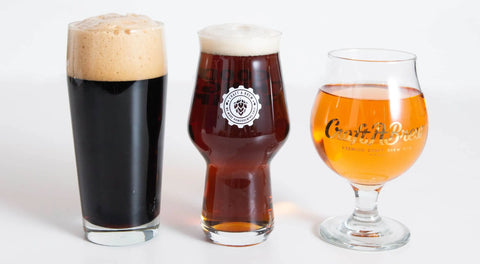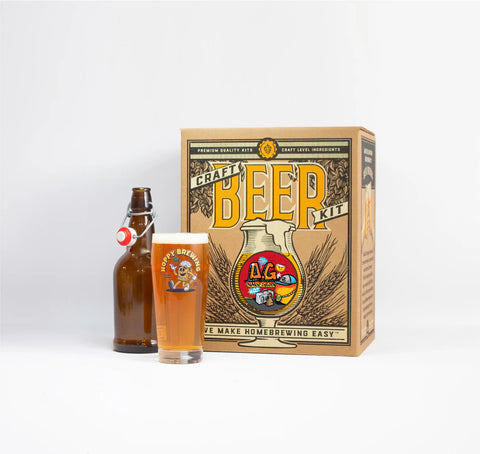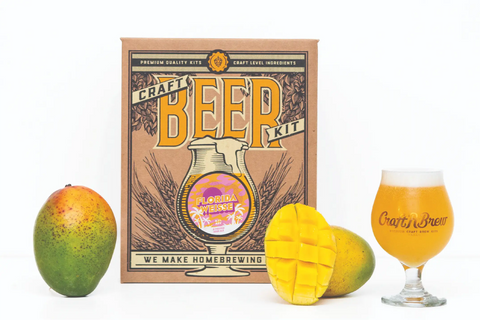TL;DR: Ale vs Lager in a Nutshell
There are 2 primary homebrewing beer types, which are different in terms of yeast, time and temperature requirements:
-
Yeast: Ales use “top-fermenting yeast” (Saccharomyces cerevisiae); lagers use “bottom-fermenting yeast” (Saccharomyces pastorianus).
-
Fermentation Temperature: Ales ferment warm (60–75°F); lagers ferment cold (45–55°F).
-
Style Profile: Lagers are clean and crisp, ranging from dark to light and high to low ABV. Ales are incredibly diverse, including IPAs, stouts, wheats, sours & beyond.;;
-
Time Required: Ales generally ferment faster, while lagers require longer conditioning.
Beginner-Friendly Tip: Most homebrewers start with ales because ale yeasts are forgiving and easily fermented at ambient room temperatures without requiring and specialty temperature control equipment.
Introduction:; Ale and Lager Craft Beer Styles Explained
When you pour a beer, you’re enjoying the product of one of two fundamentally different brewing processes: ale vs lager. While both are made from malted grains, water, hops, and yeast, the difference between ale and lager lies in the yeast and fermentation process.
Understanding these differences isn’t just trivia—it affects how you brew at home, what equipment you need, and the flavors you’ll achieve. This guide explains everything from yeast selection to fermentation temperature, helping you make informed choices about your next batch of homebrew.
1. The Yeast Makes All the Difference
The core difference between ale and lager boils down to the use of lager yeast vs ale yeast. Yeast is the secret engine behind every beer, and the main reason ale and lager are distinct categories.;
-
Ale Yeast ;(Saccharomyces cerevisiae);
-
Top-fermenting yeast, meaning it rises to the surface during fermentation.
-
Works well at warmer temperatures (60–75°F).
-
Produces fruity and sometimes spicy esters, giving ales their characteristic complexity.
-
Ideal for IPAs, stouts, porters, and Belgian-style ales.
-
Lager Yeast (Saccharomyces pastorianus);
-
Bottom-fermenting yeast that settles at the bottom of the fermenter.
-
Requires cooler temperatures (45–55°F), though some strains like W-34/70 or M54 are flexible.
-
Produces clean, crisp flavors with minimal esters.
-
Used in pilsners, bocks, helles, and other classic lagers.
Why It Matters: The yeast determines not just fermentation speed but flavor, aroma, and overall mouthfeel of the finished beer. Choosing top vs bottom fermentation yeast strains impacts the type of homebrewing beer styles you can achieve.;;
2. Fermentation Temperature Differences;
Temperature control is critical for successful homebrewing, and it’s where the differences between ale and lager brewing become most obvious.
-
Ales:;
-
Generally require fermentation temps between 60–75°F.
-
Room temperature is usually sufficient, making them ideal for first-time brewers.
-
Faster fermentation reduces the risk of off-flavors from extended fermentation.
-
Lagers:;
-
Generally require fermentation temps between 45–55°F.
-
After primary fermentation, most lagers require cold conditioning (lagering) for several weeks to smooth out flavors.
-
Temperature control tools are usually needed.
-
Hybrids:;
-
Temperature doesn’t just affect fermentation speed—it also shapes flavor and beer style identity. By fermenting lager yeast at ale temps (and vice versa) you’ll end up with styles that straddle the line between ale vs lager:
-
Steam Beer (California Common): Uses lager yeast but ferments at warmer ale temperatures. The result is a beer with crisp lager-like character layered with subtle fruity esters from warmer fermentation.
-
Kölsch: A German ale that drinks like a lager, fermented with ale yeast at cooler lager-like temps. This produces a smooth, clean beer that drinks like a lager but retains a touch of ale fruitiness.
Craft a Brew Tip: Don’t have temperature control gear? No problem. Let the weather be your beer fermentation guide. When temperatures drop, it’s much easier to ferment lagers at home! In the summer heat, opt for warm fermenting ales.;;
3. Flavor Profiles: What to Expect
Each style’s yeast and fermentation temperature create distinctive flavor differences.
-
Ales:;
-
While ale styles are extremely diverse and varied, ranging from sours to stouts, ale yeasts tend to produce stronger flavors and aromas. Warmer ale fermentation temperatures tend to coax more esters and phenols from the yeast.
-
For example, German Wheat Ale yeasts naturally produce banana and clove notes, which can be enhanced at warmer temperatures.
-
Lagers:;
-
Tend to finish cleaner and more neutral in flavor and aroma due to stable & cold fermentation. Lager yeast tends to be more neutral, contributing less to the overall finished beer than the hops and malts in the recipe.;;
-
Cold fermentation and conditioning also help draw yeast and sediment out of suspension, resulting in a super crisp finish and clean flavor.
4. Brewing Timeline: How Long Until You Can Drink It?
Ales and lagers differ in the yeast used and the temperature at which they’re fermented. But the time investment is another major difference between ale and lager styles.
-
Ales: Typically ready to drink in 2-4 weeks (depending on whether you keg or bottle carbonate). More of an “instant” gratification for new brewers.
-
Lagers: Usually require 4–8 weeks (or more) due to extended cold storage. Not only does lager yeast ferment slower at cooler temperatures, but prolonged cold aging is necessary for crisp, clean & ultra clear beer.
Why It Matters: If you're eager to taste your first homebrew quickly, ale styles are your best bet.
5. Common Styles
Ales offer more stylistic variety, making them great for experimentation. Lagers excel at drinkability and smooth finishes.
Ale Styles
-
Amber Ale
-
American Pale Ale
-
Belgian Ales
-
Brown Ale
-
Cream Ale
-
Blonde Ale
-
California Common
-
Gose
-
IPAs
-
Hefeweizen
-
Red Ale
-
Saison
-
Sour Ale
-
Stout
-
Porter
-
Wheat Ale
Lager Styles
-
Altbier
-
Bock
-
Helles
-
Light Lager
-
Pilsner
-
Rauchbier
-
Schwarzbier
-
Vienna Lager
6. Brewing at Home: Ale vs Lager;;
Brewing Ale at Home
If you're new to brewing, ale is the clear winner:
-
It’s faster
-
Easier to control fermentation
-
More forgiving of temperature swings
-
No need for expensive chilling equipment
Our Hefeweizen Kit, Irish Stout Kit and American Pale Ale Kit are all ale-based, designed for brewing success on your first try.
Brewing Lager at Home
Don’t be intimidated, you CAN make lagers at home! It does require more patience and attention to temperature control and patience. Lagers usually require:
-
A way to maintain cool fermentation temperatures, like an insulated cooler, or temperature-controlled fridge
-
Extra time for cold conditioning
-
Fining agents for a crystal clear finished product
Craft a Brew’s Light Craft Lager Kit and Czech Pilsner Kit feature forgiving W-34/70 Lager Yeast, which can tolerate warmer ale-like temperatures while still producing clean, neutral flavors.
7. Final Thoughts: The Beauty of Both
Whether you love bold IPAs or light lagers, understanding the difference helps you enjoy beer more — and brew better at home. Both have their place, but ales are more beginner-friendly and flexible, making them ideal for your first few batches. There’s also room for experimenting with yeast strains and temperatures to craft ale-lager hybrids like Kolschs and Steam Beers.
Ready to Brew Your First Beer? Explore Craft a Brew’s beer making kits, which include ales, lagers & hybrids. With step-by-step instructions, you can master craft beer styles explained in a home environment.
Ready to Brew Your First Ale?
Explore our beer kit collection to find beginner-friendly ales you can brew with confidence — no chilling equipment required.





